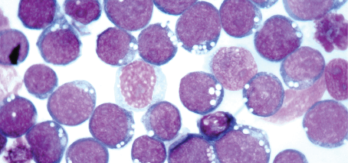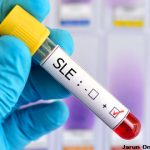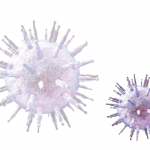
Epstein-Barr virus stained with H&E.
National Cancer Institute / Science Source
A strong association between Epstein-Barr virus (EBV) infections and systemic lupus erythematosus (SLE) has been known since the 1970s. Although the etiology of SLE is not fully established, multiple genetic factors and polymorphisms in genes involved in the immune system have been implicated, with environmental factors also contributing to the development of this complex condition.
Lupus is a rare, chronic, autoimmune disease that causes inflammation within skin and joints, with potential for major damage to the kidneys, lungs and brain, along with other morbidities. EBV is a nearly ubiquitous virus that infects the majority of the world’s population. Following exposure to the virus, it remains in a person’s system, usually dormant except for occasional reactivation of the lytic cycle of viral reproduction. A surrogate for EBV reactivation can be measured by the sero-prevalence of antibodies elicited by the immune system’s response to viral capsid antigen and early antigen.
A Genetic Connection
One of the big questions rheumatologists receive from their patients is, “If I have lupus, will other members of my family get it?” says Judith James, MD, PhD, a rheumatologist, researcher and vice president of clinical affairs at Oklahoma Medical Research Foundation, Oklahoma City. A genetic connection exists, and family members of SLE patients are known to be at greater risk than the general population, she says. “But can we identify which of these family members might be more prone to getting lupus? Could we identify them years before they develop lupus and recruit them for primary prevention trials?”
Dr. James is a co-author of a study, published in Annals of the Rheumatic Diseases, exploring whether reactivation of EBV and single nucleotide polymorphisms in EBV are associated with a transition to SLE.1 “Ours is the first study to try to understand the cause/effect relationship between viral reactivation and SLE—to see if EBV reactivation precedes SLE clinical onset or autoantibody development,” she says. Her study found that baseline viral capsid antigen and early antigen immunoglobulin levels are higher in those SLE patients’ family members who later transitioned to SLE than in those who did not transition and with healthy controls.
The researchers looked at 436 individuals who were relatives of SLE patients but did not themselves have SLE, gathering detailed demographic, environmental and clinical information and blood samples with ELISA (enzyme-linked immunosorbent assay) tests for antibodies against various viral antigens, including viral capsid antigen and early antigen. The participants had been enrolled in the Lupus Family Registry and Repository and the Systemic Lupus Erythematosus in Gullah Health studies, and gave their consent to be recontacted by researchers. They were approached approximately six years after the baseline testing. The aim was to see if they transitioned to SLE over those years. Thirteen percent of the relatives, in fact, transitioned to SLE by the time of follow-up contact.
“Our research looked at a specific type of immune response to EBV,” Dr. James says. “The data show that the relatives had increased reactivation of EBV prior to transitioning to SLE and increasing levels of EBV antibodies associated with SLE disease transitioning. If you have antibodies to early antigen, then you’re at highest risk for transitioning to SLE.”
Reactivation of EBV could be used to identify patients who require closer scrutiny for the development of SLE. Rheumatologists could ask lupus patients’ family members, especially those who test positive for anti-viral capsid antigen and anti-early antigen, to come back for reevaluations, perhaps annually, while keeping a lookout for the typical signs and symptoms of lupus, such as photosensitivity, low white blood cell counts, oral/nasopharyngeal ulcers, arthritis, rashes, fatigue, muscle aches and fevers.



